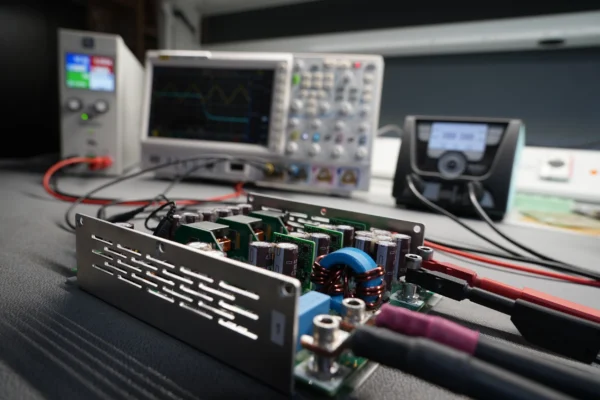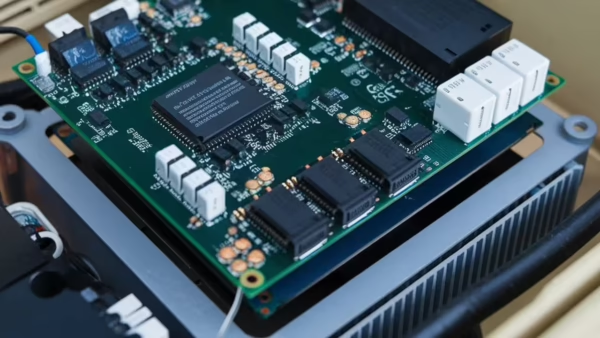DC grid as network infrastructure in industry
Reading time – approx. 5 minutes – This article shows the advantages that a DC grid offers in industrial energy supply architecture. The main focus is on energy efficiency and energy flexibility in production.
Today, the term DC grid is mostly used for a centralised direct current grid infrastructure in industrial or production facilities. This means that all components within a closed system are supplied via a direct voltage source. They are not supplied via the conventional alternating current grid as was previously the case. In addition to an ever-increasing number of studies on the DC grid, there is also a growing number of calls from industry to switch their own production to a DC grid. This trend demonstrates its versatility.
Difficulties with the alternating current supply
In order to understand the underlying problems that are leading to a rethink in industry, it is necessary to take a look at the most important electrical consumers. With an electricity consumption share of approx. 70%, electric motors have the largest energy requirement in production.
For the efficient operation of an electric motor, a frequency converter is required to control the speed. These frequency converters, which are supplied with alternating current, use a rectifier to generate an intermediate DC voltage circuit. This DC circuit is then used by an inverter to generate the AC voltage required for the three-phase motor. The generated AC voltage has the corresponding frequency and voltage. This results in two challenges affecting potential DC grid integration.
Challenge 1: Frequency converters generate harmonics when rectifying the AC voltage, which distort the supply network. Active and passive mains filters are required to limit these voltage distortions in the supply network to legal requirements. The electronics required for the rectifier and filter increase costs on one hand. Additionally, it is not possible to integrate the electronics efficiently into the motor. For this reason, frequency inverters are usually housed in control cabinets. This housing results in costs and efficiency losses.
Challenge 2: If an electric motor is operating in braking mode, the direction of the energy flow changes. However, the rectifier in the frequency inverter does not allow energy to be fed back into the AC voltage network, which makes it necessary to dissipate the energy from the DC link. This energy is usually dissipated via an externally connected braking resistor. The resistor converts the energy into heat, which can then no longer be utilised.
Cost reduction with a DC grid
Until now, the supply structure has been unidirectional via long-distance lines, interconnected grids and load distributors from the producer to the consumer. The use of decentralised, weather-dependent, fluctuating energy generators such as photovoltaics and wind energy means that a high base load supply is necessary. This ensures security of supply. Consequently, generation capacities are increasingly being used inefficiently. Supply bottlenecks can occur because the energy available on the generation side and the demand on the consumer side are currently not harmonised.
At the same time, the complexity of production plants is increasing due to electronically synchronised movement sequences. In the event of power failures, this leads to production downtime and production errors, as was impressively demonstrated by the 40-minute power outage at Samsung in South Korea in 2018. During that period, 11% of the flash memory produced each month was destroyed. In total, this caused damage of around 40 million US dollars.
By switching to a DC grid, energy generated on site, both from renewable sources and recuperative processes, can be stored more efficiently. The energy storage required for this reduces energy costs. This is especially true when buffering peak loads and bridging grid outages, thanks to the stable nature of a DC system.
The smart grid
The integration of the electronics into the motor, made possible by the elimination of filters and rectifiers, also enables better recording of status parameters. With the help of status parameters such as temperature, energy requirements or error messages from the individual components, network management within a DC grid can ensure energy cost and process-optimised production control. This is a basic prerequisite for the successful implementation of the Industry 4.0 standard.
Conclusion – DC grid
For a long time, “never change a running system” applied to industrial energy supply. In times of a massive rethink of energy policy and a technological leap in the development of energy storage and power electronics, this attitude is no longer justified. In addition to a significant reduction in costs and a saving in energy requirements, production supplied via the DC grid is more robust with regard to fluctuating grid quality. It is able to react flexibly to changing energy supplies.
As a member of the ODCA (Open Direct Current Alliance), Querom Elektronik GmbH is part of an alliance of companies from German industry. The alliance is pursuing the goal of establishing DC grids on the market. This is because the increased use of DC technologies will help to achieve a sustainable and CO2-neutral world.
As a member of the Open DC Alliance (ODCA), Querom is part of an alliance of national and international companies. These companies have set themselves the goal of helping to build an international DC ecosystem. This would expand the DC grid globally.



